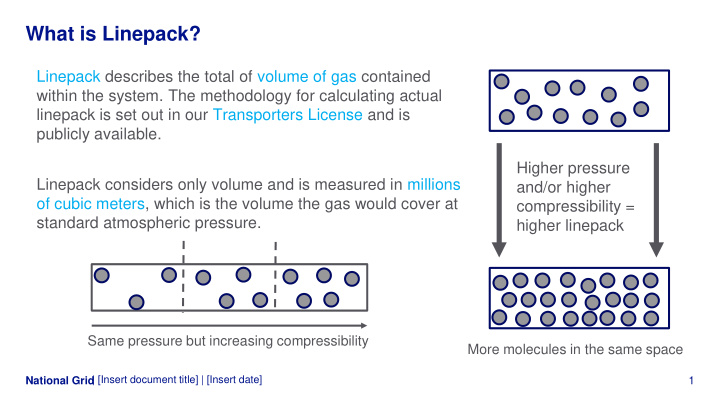



What is Linepack? Linepack describes the total of volume of gas contained within the system. The methodology for calculating actual linepack is set out in our Transporters License and is publicly available. Higher pressure Linepack considers only volume and is measured in millions and/or higher of cubic meters, which is the volume the gas would cover at compressibility = standard atmospheric pressure. higher linepack Same pressure but increasing compressibility More molecules in the same space National Grid | [Insert document title] | [Insert date] 1
Physical considerations for Linepack As linepack is analogous to average pressure across the network, it is key to the physical operation of the network. Higher entry risk Increasing Linepack but greater flexibility Lower entry risk but reduced flexibility National Grid | [Insert document title] | [Insert date] 2
Seasonal Variation in Linepack Lower in the summer, higher in the winter With winter comes: • Higher demands • Changing diurnal demand Winter Winter Summer profiles • Increased pressure drops • Larger daily linepack swings To protect exit pressures we must maximise flexibility of Linepack Demand the NTS National Grid | [Insert document title] | [Insert date] 3
Summer Linepack Context? Typical Pressure Drop 100 Maximum flow is 80 achieved when one end of a pipe is at its max 60 pressure and the other 40 end is at its minimum. Winter Summer Lower demands result in: The range of maximum • Lower pressure drops to minimum pressures can be as high as 45 bar • Lower natural flow rates in the winter but only • Compression to manage high entry flows around 20 bar in the summer. National Grid | [Insert document title] | [Insert date] 4
Winter Linepack Instantaneous Demand over the Day 550 Context? The differential 350 between supply and demand at tea time on 150 a cold winters can Winter Summer result in as much as 5 High demands and strong diurnal profile results in: mcm being lost from • linepack every hour. Large pressure drops This is enough gas to • Large linepack swings supply 4000 • Lower extremity pressure due to frictional losses households for a year! • Requirement to maintain higher pressures in the middle of the network National Grid | [Insert document title] | [Insert date] 5
Manging the transition • Requires PCLP to be Transitions different from OLP <2.8 mcm Desired End • Avoid sharp changes Position within an ‘efficiency’ zone • Large transitions could be required if stock level has drifted over a period of days D D-1 D-2 D-3 D-4 Start Position • Balance safety, efficiency and minimise entry into market National Grid | [Insert document title] | [Insert date] 6
Transparency Trading behaviour Very simply when we buy gas we need more linepack, when we sell gas we need less linepack. This is normally because we are transitioning between desired linepack regions (for efficiency) or need to arrest a steady increase or decline in linepack. But how much more/less gas do you need? We don’t publish ‘target’ as to minimise our influence in the market but…. • Trends on OLP, PLCP and Demand can give an indication • Just because PCLP is largely different to OLP doesn’t indicate a trade National Grid | [Insert document title] | [Insert date] 7
Recommend
More recommend